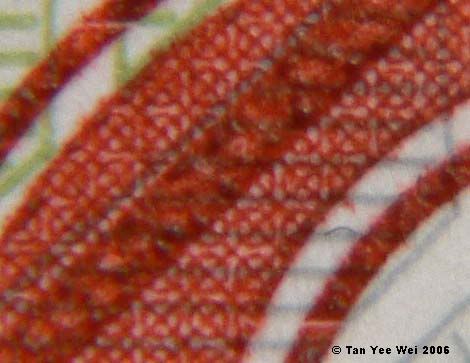Tactless colleague; a camera that can see details 7 microns across
Some people have this remarkable ability of being able to offend large tracts of the human population without having to expend any effort.
Yesterday at work, one of the cooks cut an orange and left it at the waiter’s station for us floor staff to eat at our leisure. Three of us were happily biting into the juicy fruit, sucking occasionally during the bite to prevent the juices from dripping, when one of the waiters asked, “these oranges were not used in prayers were they?”
The restaurant has an altar in the kitchen.
Without giving anyone an opportunity to say “I don’t know,” he explained, “If it has been used for prayer then I cannot eat it.”
Ah, he’s a probably Christian, Jew or Muslim. One god mah.
We shrugged, still engrossed in making sure none of the orange juice dripped onto the floor.
“It’s unclean,” he continued. Two pairs of eyes immediately snapped to stare at him, the eyelids gradually narrowing into slits, eyebrows furrowing in disapproval. The expressions lasted an instant, before evaporating in a puff as diplomacy and politeness displaced the sha qi(杀气).
Frankly, that last statement was completely unnecessary. Everyone would understand if you believe in your religion, but most people find it offensive when you put down other religions.
***
On a different note, I found out how to make full use of that close-up lens I got 3 months ago. Bolt it onto the camera (duh...) and wind the lens all the way to full telephoto. It can only focus at objects about 15 cm away from the camera, in a very narrow range of about 3 cm - it is difficult to use. But once it’s got right, the results are startling.
Imagine a magnification factor of 1.56, when the best factor without the close-up lens was an already magnificent 0.62. That’s 2.5 times more magnification, but at the cost of preposterous chromatic aberration and defocusing away from the centre of the image. That is the price, a fair price I’d say, to pay for a piece of optics that cost me a mere AU$5.
Still, the set up reveals details that the naked eye would never see, such as the following microprint on the HK$50 note.

This is a 100% crop. Even the printing imperfections are visible (red smears).
Imagine that, visible printing imperfections on a banknote!
The previous image shows the highlighted region below (blue rectangle on the centre '50').

At this level of magnification, 2.3 cm worth of a ruler would span the entire frame. Since the frame is 3264 pixels across, it would mean that there are 136 pixels per mm, or 0.0074 mm per pixel.
A more fantastic way of putting it is,
My camera can resolve details of 7 microns.
The manufactured world is mostly flat/ homogeneous at scales smaller than the intended application; tomorrow, I’m going to dissect some plants for some supermacro shots.
Watch this space!
Photographs
Interesting reads
Yesterday at work, one of the cooks cut an orange and left it at the waiter’s station for us floor staff to eat at our leisure. Three of us were happily biting into the juicy fruit, sucking occasionally during the bite to prevent the juices from dripping, when one of the waiters asked, “these oranges were not used in prayers were they?”
The restaurant has an altar in the kitchen.
Without giving anyone an opportunity to say “I don’t know,” he explained, “If it has been used for prayer then I cannot eat it.”
Ah, he’s a probably Christian, Jew or Muslim. One god mah.
We shrugged, still engrossed in making sure none of the orange juice dripped onto the floor.
“It’s unclean,” he continued. Two pairs of eyes immediately snapped to stare at him, the eyelids gradually narrowing into slits, eyebrows furrowing in disapproval. The expressions lasted an instant, before evaporating in a puff as diplomacy and politeness displaced the sha qi(杀气).
Frankly, that last statement was completely unnecessary. Everyone would understand if you believe in your religion, but most people find it offensive when you put down other religions.
On a different note, I found out how to make full use of that close-up lens I got 3 months ago. Bolt it onto the camera (duh...) and wind the lens all the way to full telephoto. It can only focus at objects about 15 cm away from the camera, in a very narrow range of about 3 cm - it is difficult to use. But once it’s got right, the results are startling.
Imagine a magnification factor of 1.56, when the best factor without the close-up lens was an already magnificent 0.62. That’s 2.5 times more magnification, but at the cost of preposterous chromatic aberration and defocusing away from the centre of the image. That is the price, a fair price I’d say, to pay for a piece of optics that cost me a mere AU$5.
Still, the set up reveals details that the naked eye would never see, such as the following microprint on the HK$50 note.

This is a 100% crop. Even the printing imperfections are visible (red smears).
Imagine that, visible printing imperfections on a banknote!
The previous image shows the highlighted region below (blue rectangle on the centre '50').

At this level of magnification, 2.3 cm worth of a ruler would span the entire frame. Since the frame is 3264 pixels across, it would mean that there are 136 pixels per mm, or 0.0074 mm per pixel.
A more fantastic way of putting it is,
My camera can resolve details of 7 microns.
The manufactured world is mostly flat/ homogeneous at scales smaller than the intended application; tomorrow, I’m going to dissect some plants for some supermacro shots.
Watch this space!
Photographs
Interesting reads
Labels: microscopy, observations, personal, photography

<< Home